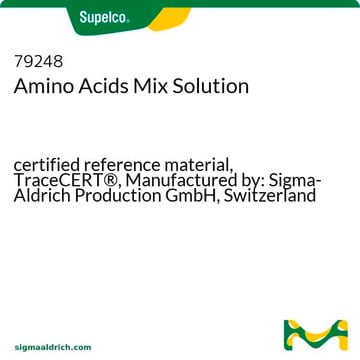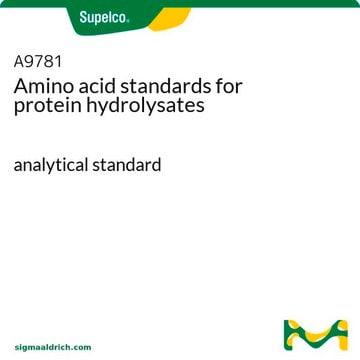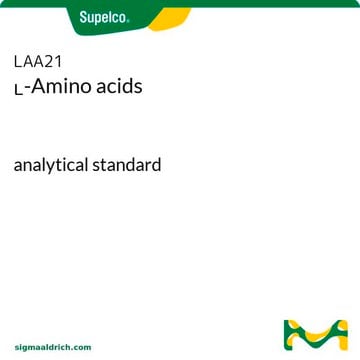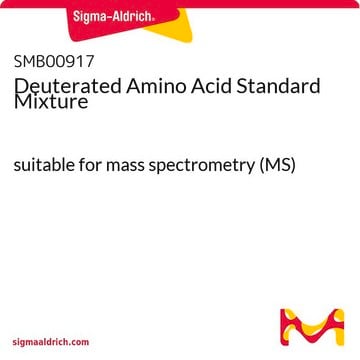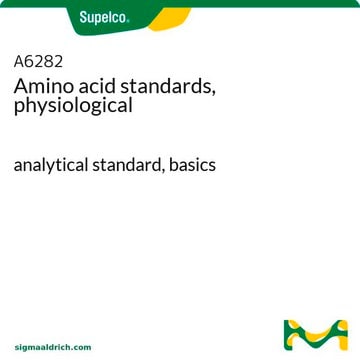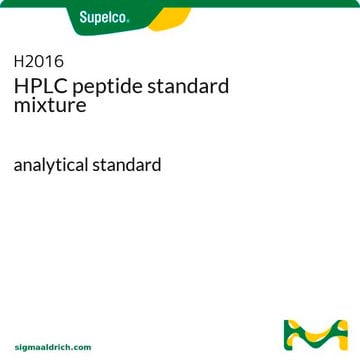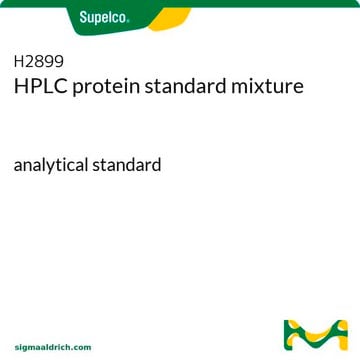A2161
Amino acid standards for fluorescence detection
analytical standard
Zaloguj sięWyświetlanie cen organizacyjnych i kontraktowych
About This Item
Kod UNSPSC:
85151701
eCl@ss:
32160406
NACRES:
NA.24
Polecane produkty
klasa czystości
analytical standard
klasy chemiczne analitów
amino acids, peptides, proteins
metody
HPLC: suitable
gas chromatography (GC): suitable
Zastosowanie
food and beverages
format
multi-component solution
temp. przechowywania
2-8°C
Zastosowanie
Refer to the product′s Certificate of Analysis for more information on a suitable instrument technique. Contact Technical Service for further support.
Inne uwagi
suitable for fluorescence detection
Qualitative standard. Amino acids and related compounds are in 0.1N HCl.
This page may contain text that has been machine translated.
Analit
Opis
L-Alanine
Ammonium chloride
L-Arginine
L-Aspartic acid
L-Cystine
L-Glutamic acid
Glycine
L-Histidine
L-Isoleucine
L-Leucine
L-Lysine
L-Methionine
L-Phenylalanine
L-Proline
L-Serine
L-Threonine
L-Tyrosine
L-Valine
Zobacz wszystko (18)
Hasło ostrzegawcze
Warning
Zwroty wskazujące rodzaj zagrożenia
Zwroty wskazujące środki ostrożności
Klasyfikacja zagrożeń
Met. Corr. 1
Kod klasy składowania
8B - Non-combustible corrosive hazardous materials
Klasa zagrożenia wodnego (WGK)
nwg
Temperatura zapłonu (°F)
Not applicable
Temperatura zapłonu (°C)
Not applicable
Choose from one of the most recent versions:
Certyfikaty analizy (CoA)
Lot/Batch Number
Don't see the Right Version?
If you require a particular version, you can look up a specific certificate by the Lot or Batch number.
Masz już ten produkt?
Dokumenty związane z niedawno zakupionymi produktami zostały zamieszczone w Bibliotece dokumentów.
Klienci oglądali również te produkty
Somaieh Zafari et al.
Plant physiology and biochemistry : PPB, 99, 11-20 (2015-12-29)
Lead (Pb) is a hazardous heavy metal present in the environment which elicits oxidative stress in plants. To characterize the physiological and biochemical basis of Pb tolerance, Prosopis farcta seedlings were exposed to Hoagland's solutions at six different Pb concentrations
Hannaneh Tashackori et al.
Journal of plant physiology, 232, 115-126 (2018-12-12)
Lignans are diphenolic compounds produced in plants via coupling of two coniferyl alcohol molecules with the aid of a dirigent protein to form pinoresinol (PINO). The latter is reduced via lariciresinol (LARI) to secoisolariciresinol by the bifunctional pinoresinol-lariciresinol reductase (PLR).
Nasz zespół naukowców ma doświadczenie we wszystkich obszarach badań, w tym w naukach przyrodniczych, materiałoznawstwie, syntezie chemicznej, chromatografii, analityce i wielu innych dziedzinach.
Skontaktuj się z zespołem ds. pomocy technicznej
